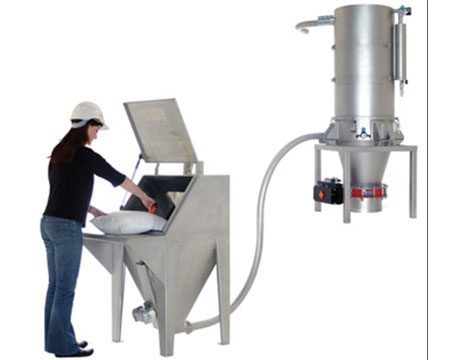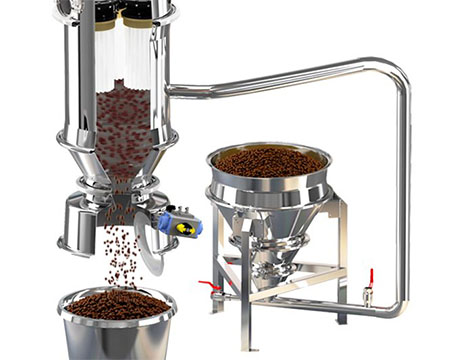Copyright © 2021 Zhangjiagang ChiYu Automation Equipment Co., Ltd. by iwonder.cn All rights reserved. Site Map
Material handling systems are critical in industries like manufacturing, agriculture, food processing, and pharmaceuticals. Among the various methods used to transport materials, pneumatic and mechanical conveying are two of the most common. Each system has its unique principles, advantages, and applications. This article delves into the key differences between pneumatic and mechanical conveying, examining their working principles, applications, benefits, and limitations.
Pneumatic conveying involves the movement of bulk materials through pipelines using air or another gas as the conveying medium. This system uses pressure differences or a vacuum to create a flow of air that transports materials.
Dilute Phase Conveying: Materials are suspended in the air and transported at high velocities.
Dense Phase Conveying: Materials move in a more concentrated form, often in slugs or plugs, at lower speeds.
Vacuum Conveying: Uses negative pressure to pull materials through the pipeline.
Pressure Conveying: Uses positive pressure to push materials through the pipeline.
Versatility: Suitable for a wide range of materials, including powders, granules, and fine particles.
Hygiene: Enclosed systems reduce contamination, making them ideal for food and pharmaceutical industries.
Flexibility: Can handle complex routing over long distances and in tight spaces.
Ease of Automation: Integrates well with modern automated systems.
Energy Consumption: Requires significant energy to generate the airflow.
Wear and Tear: High-speed material flow can cause abrasion and reduce system lifespan.
Capacity: Less suitable for handling heavy or bulky materials compared to mechanical systems.

Mechanical conveying uses physical components such as belts, chains, or screws to move materials. These systems rely on mechanical force rather than airflow.
Belt Conveyors: Transport materials on a continuous belt.
Screw Conveyors: Use a rotating screw to move materials through a tube or trough.
Bucket Elevators: Lift materials vertically using a series of buckets attached to a belt or chain.
Chain Conveyors: Move materials along a track using a continuous chain.
Vibratory Conveyors: Use vibration to move materials along a flat surface.
High Capacity: Can transport larger volumes and heavier materials.
Energy Efficiency: Consumes less energy compared to pneumatic systems.
Durability: Robust design minimizes wear and tear.
Cost-Effectiveness: Lower operational costs for large-scale operations.
Limited Flexibility: Less adaptable to complex routing or long distances.
Maintenance: Requires regular lubrication and upkeep.
Open Systems: More prone to material spillage and contamination in some cases.
| Aspect | Pneumatic Conveying | Mechanical Conveying |
|---|---|---|
| Conveying Medium | Air or gas | Mechanical components |
| Material Suitability | Fine powders, granules, lightweight materials | Heavy and bulky materials |
| Energy Consumption | Higher | Lower |
| System Design | Enclosed, flexible routing | Open or partially enclosed, fixed routing |
| Maintenance | Frequent replacement of wear parts | Regular lubrication and part inspection |
| Hygiene | Better due to enclosed design | May require additional measures for hygiene |
| Applications | Pharmaceuticals, food, chemicals | Mining, agriculture, heavy industries |
Pharmaceutical Industry: For precise and contamination-free material transport.
Food Processing: Ideal for conveying delicate powders like flour or sugar.
Chemical Industry: Handles hazardous or toxic materials safely.
Plastics Manufacturing: Moves plastic granules and resins efficiently.
Mining: Moves heavy ores and minerals efficiently.
Agriculture: Transports grains, seeds, and fertilizers in bulk.
Construction: Handles raw materials like sand, gravel, and cement.
Recycling: Conveys metals, plastics, and other materials for processing.

Material Characteristics
Lightweight, dusty materials: Pneumatic conveying.
Heavy, abrasive materials: Mechanical conveying.
Distance and Routing
Long, complex routes: Pneumatic conveying.
Short, straightforward routes: Mechanical conveying.
Hygiene and Contamination Control
Sensitive applications: Pneumatic conveying.
Less critical applications: Mechanical conveying.
Operational Costs
Initial investment vs. long-term maintenance and energy costs.
System Capacity
High-volume applications: Mechanical conveying.
Moderate volumes with precision: Pneumatic conveying.
Pneumatic and mechanical conveying systems serve distinct purposes, and their selection depends on specific material handling requirements. Pneumatic conveying offers flexibility, cleanliness, and automation advantages, making it ideal for delicate and lightweight materials. In contrast, mechanical conveying excels in handling heavy loads with lower energy consumption and higher capacity.
By understanding the differences, advantages, and limitations of both systems, industries can make informed decisions to optimize their operations, ensuring efficiency and cost-effectiveness. Whether moving fine powders in a pharmaceutical plant or heavy ores in a mining operation, choosing the right conveying method is crucial to achieving operational success.